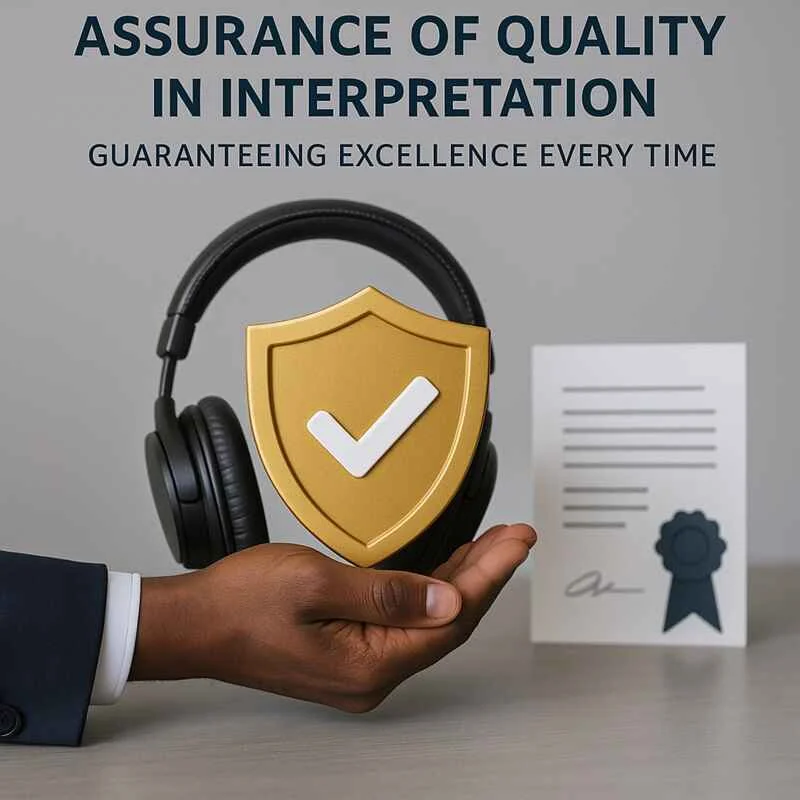In this growing world, effective communication is essential. However, diversity can create communication gaps, making interpretation a crucial solution. Interpreters bridge these gaps by converting language from its source to the target language, ensuring clarity and understanding. Quality in Interpretation is vital, as it is required in courtrooms, schools, medical consultations, events, and beyond. Simply converting one language to another is not enough—successful interpretation depends on a high-quality framework that ensures accuracy, cultural sensitivity, and professionalism. Therefore, maintaining Quality in Interpretation is key to overcoming barriers and fostering meaningful communication.
This blog discusses the key elements of quality assurance in interpretation and explains why maintaining accuracy, professionalism, and trust in all dealings depends on it.
The Importance of Quality Assurance in Interpretation
As interpretation is required in areas where one misinterpreted sentence can cost someone their lives, like in courtrooms or medical consultations, it can also affect the future understanding of students if lectures are misinterpreted. Therefore, it is very important to have a quality assurance plan and policy for precise and effective communication.
Fundamentals of Interpretation Quality Assurance
Recognising the needs of the client
The most important step is recognizing the needs of the client so that one is aware of the nature of the event, its topic, the audience targeted for it, the necessary language, dialect, and how the interpretation will be performed, like Whispered, Simultaneous, or Consecutive. This is such a crucial step and will lead to the service delivery that satisfies clients’ needs.
Putting Together Appropriate Interpreters
Selecting the right, professional, and experienced subject matter interpreters is important for effective interpretation. To guarantee domain accuracy and professionalism, certified professionals with proven experience in legal, medical, technical, or community interpreting are selected.
For instance, TransLinguist sources from a worldwide network of certified interpreters who are carefully matched to each other
Contextual and Cultural Sensitivity
Interpretation is not only about words, but it is the service to ensure that the accurate, precise meaning in the same tone, culture, and way is delivered to the other person; hence, it is very crucial that the interpretation is done in high quality to ensure effective communication.
Interpreter Training and Continuous Assessment
Reputable businesses consistently invest in the training of interpreters, emphasizing not only language proficiency but also moral values, confidentiality, and the use of the proper tools and processes. Regular performance reviews, feedback loops, and peer evaluations are all crucial elements of quality assurance that support continuous improvement.
Supervisor supervision and real-time monitoring
Live supervision and technical support guarantee that any linguistic or technical issues are resolved in real time for large-scale or high-stakes assignments (like conferences or broadcast events). QA teams keep an eye on client satisfaction, protocol compliance, and interpretation quality.
Evaluation and Comments After the Assignment
After the session is concluded, a formal debriefing session is held where we ask clients about their feedback on the performance, professionalism, timeliness, and content accuracy of interpreters. This will make clients more comfortable with us and build trust.
Technology and Tools for QA
- Digital platforms are also used by contemporary interpreting services to improve QA:
- For internal QA audits, remote interpreting platforms provide real-time session recordings.
- Based on interpreter performance, which will be done post-session reviews, they will be given a score in tracking performance trends
- With the help of confidentiality, all the data is held safely and is kept secure.
- By avoiding last-minute substitutions, scheduling systems ensure consistency.
Impact of Excellent Interpreting in Legal Settings in the Real World
A trial’s verdict could be altered by a misconstrued testimony. Every word is given the weight it deserves thanks to certified legal interpreters.
- In the medical field, interpreting symptoms and causes may save someone’s life.
- Interpreters who are fluent and are aware of the culture will promote trust and make transactions in the business world easily.
In summary: Assurance Brings About Excellence.
Clarity and trust in multilingual communication are based on quality assurance in interpretation, which is not a box-ticking exercise. Every step of the quality assurance procedure contributes to the provision of reliable and important interpreting services, from careful preparation and the hiring of qualified interpreters to cultural sensitivity and post-session evaluation.
We at TransLinguist are dedicated to improving the standard of interpretation. We make sure that every interaction is not just interpreted but fully understood by fusing the accuracy of human expertise with cutting-edge technologies and a client-centric methodology. Visit TransLinguist to get more info and updates.
Get in contact now with the team of Translinguist because good interpreting is crucial when communication is most important.
FAQs
What is the quality assurance process in translation?
In Translation, we make sure that every translated content has undergone 3 main process to ensure quality which are: Translation, Editing and proofreading and Client Review and Feedback.
What is the role of quality in developing performance excellence?
Quality is the foundation of performance excellence. It ensures that every service, product, or process consistently meets or exceeds customer expectations. In your case (offering web, design, and marketing services), quality builds trust with clients, business credibility and enhances growth.
What is the main goal of quality assurance (QA)?
The main goal is to make sure that there is no compromise on Client satisfaction and the deliverable is delivered with high quality.
What are the 5 functions of quality assurance?
Planning, Designing Processes, Monitoring, Evaluation & Audits, Evaluation & Audits



